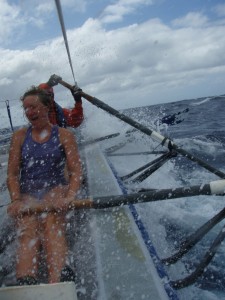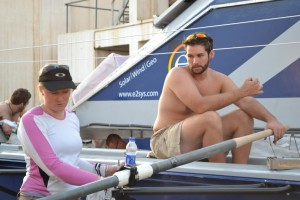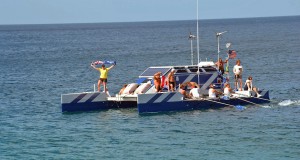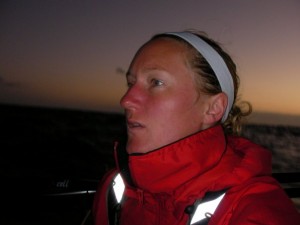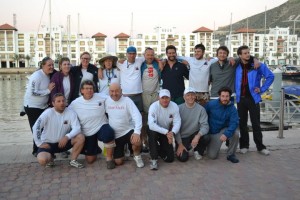Since I originate from an area far from the ocean I have never really been into sailing the oceans, but can understand the sense of freedom it probably creates. And back in the early 2000´s I met a young girl at a friends house in London, who wanted to row one of the worlds oceans. Her name was Roz Savage. And she did and is still doing this today. Lately I have been following one of few explorers I really admire, Erden Eruc, who right now is somewhere outside the coast of Africa in his rowing boat. And, there is no doubt, one of the greatest feats I have heard about, and odd stories in the history of adventure, is the story about Anders Svedlund. Suddenly I ended up getting really interested in ocean rowing and the people who do it. Then, not long ago, I read about an energetic Australian girl from the island of Tasmania and I thought, they were a tough a lot of people I remember from my visit there back in 1994, so she must be hard as nails. She is. Just recently she became the first Australian woman to row an ocean. Which is an amazing feat. This is her story!
The First Australian Woman To Row An Ocean
by
Margaret Bowling
This season a new concept ocean rowing boat broke the Atlantic E-W speed record.
It was the ocean rowing trimaran Triton. From the moment he saw it, Big Blue builder and owner David Davlianidze knew the concept had huge potential. Initially his concept was for an ocean rowing catamaran with 6 rowing seats and accommodation for a crew of 14. David began working with a skipper and they came up with a plan for a record attempt expedition. Their aim was to find 12 strapping rowers capable of smashing the holy grail of ocean rowing, the speed record for crossing the Atlantic E-W, whom they would join as skipper and engineer. Over the course of the next year the skipper left the project and David was forced to postpone the expedition by a year. In the process he lost a few team members who, having already trained hard for a year and put various things in their lives on hold, decided to move onto pastures greener.
Following the departure of the skipper, and some of the rowers, sponsorship that had been promised didn’t materialise and the expedition suffered a severe funding shortfall. The change in team structure did result in one positive outcome though – the team managed to recruit three time ocean rower Angela Madsen as their skipper. With Angela’s assistance a full compliment of 16 team members (the largest ever ocean rowing crew) was found.
Angela told me that the boat had performed so well at sea trials back in November that she was convinced we would smash the record. What she hadn’t been able to account for was just how heavy the boat was to become. Due to the significant funding shortfall that resulted from the skippers departure David was forced to cut corners in order to be able to complete the project at all. This meant that the final stages of the build were done with heavier materials than had been accounted for and the boat ended up sitting an estimated 10 inches lower in the water than at sea trials. I must stress that it’s a huge credit to David that the boat made it onto the water at all. It was clear he had built her well, even though when I first arrived in the boat yard in Agadir it was she instantly struck me as one of the most eccentric looking vessels I would ever lay eyes on, let alone row.
I had joined the row at the last minute when one of the crew broke her hand just before she was due to fly out to the start line in Morocco. I was offered her seat and, as all foolish adventurers do, I jumped at the chance. So with less than a week to go I did a whip around of my fantastic sponsors, friends and family and managed to get all of my gear together and off I flew to Agadir in Morocco to join the expedition of a lifetime.
Within a couple of days of departure from Agadir we knew that we would never break the record with the boat as heavily laden as she was. We were doing 1-2 knots slower than expected. So, having consulted the Ocean Rowing Society International and verified that we could restart the record attempt further south, we pulled in at one of the final ports along the Moroccan coastline with the aim of getting rid of as much food and gear as possible and lightening her up.
In the process of pulling into this tiny one horse Moroccan town, due to unsuitable moorings, we managed to beach the boat. At the point in the trip when we were all tearing out hair out with boredom I made my watch play ‘most memorable moment’ and every single one of them said that beaching the boat in the Sahara was theirs. It was certainly an interesting start and we were very lucky not to have damaged the rudders in the process. If we had we would have had to knock the whole expedition on the head there and then. Fortunately we managed to get away unharmed and almost a tonne lighter.
I supported Angela’s decision to leave so much of our food in the Sahara. I still stand by it because, at the time, with the knowledge we had, it was the right decision. In the end the journey took over 50 days, instead of the estimated 30, and we crawled into Barbados on our last bag of Clif bars, having eaten very little else for the best part of a week. Unfortunately, even as we neared the finish line, the boat barely sat any higher in the water than when we’d started and it became apparent that the fundamental problem was not how much food and gear we’d had onboard but the weight of Big Blue herself.
Our next major hurdle came not long after we’d left Morocco for the second and final time. Unbeknownst to the team, Angela and I were seriously contemplating pulling into the Cape Verde Islands, the last port of call before heading into the big blue and really beginning an Atlantic crossing but too far west to qualify for a record attempt. We had discovered a large crack forming on the side of the cabin. Our initial fear was that the crack would spread underneath the cabin and that as soon as we hit bad weather the cabin would fall off its supporting struts straight into the ocean. After consulting with David and assessing the situation we decided that the boat was structurally sound and that the crack was just a result of some bend and flex caused by the two pods shifting and that it wouldn’t spread into an area that would affect the boat’s safety. So we carried on.
Technical hurdles largely over and done with we then hit a huge emotional hurdle – we realised that the record was well and truly out of our grasp. This hit the original crew members who had been training up to 25 hours a week for almost two years the hardest. At this point it was a blessing that the pinch on funds had led to David recruiting a number of people who hadn’t been quite so committed to such an extreme training regime. They helped inject an element of calm into the team at a time when a couple of them were potentially on the verge of doing something rash. Whilst I am fiercely competitive I had enjoyed the journey as much as the competition of the race when I’d rowed in the 2007 Atlantic Rowing Race. I knew that just managing to complete an ocean row would be a feat in itself and that we would have many incredible days ahead of us, record or no record. I was right. What started out as a record attempt Atlantic row ended up being a fabulous adventure aboard a craft that was madder than anything I’ve ever known. And as with all great adventures it was overcoming the problems that enabled us to complete the journey and left us with stories that our grandchildren will be telling their grandchildren.
Margaret Bowling is an expedition manager specialising in polar and ocean expeditions. She works with teams on every aspect of their expeditions and adventures, from crew selection through to sponsorship and PR. Visit her homepage at http://margaretbowling.wordpress.com/


